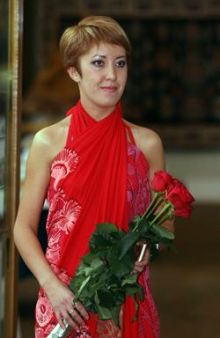The Enamel Painting Festival, the idea of which belongs to Yulia Borodai, a well-known enamel artist, was organized by the Museum of Ukrainian Folk Decorative Art. The festival features interesting works by our compatriots and guests from Georgia, Hungary, Romania, Russia, and Spain.
Although enamel art traditions are usually associated with Arab, Balkan, Transcaucasian, and Black Sea coast countries, this art has long been familiar in Ukraine. For example, enamel was used in Scythian gold ornaments, Kyivan Rus kolts (pendants) and diadems, and the items of worship dating back to the glorious times of the Ukrainian baroque.
In the late 19th century enamel painting began to develop as a self-sufficient art, only to sink into oblivion in the Soviet era. It was Ukrainian independence that gave this art a powerful impetus. So the main goal of this festival is to popularize enamel painting. “It is high time we not only had held this kind of festival but also brought Ukrainian masters together in an association similar to those abroad,” Ms. Borodai says. “This will enable us to become integrated, fill high-profile orders, establish schools (there is only one now, created by my father Oleksandr Borodai), mingle with our foreign colleagues, and exchange experience with them.”
Actually, this issue was high on the agenda of the roundtable “Enamel Art across Time and Space” held last Wednesday. Besides, the website of Ukrainian enamel artists, www.enamel.kiev.ua, has been officially launched. It is also planned to publish an album titled “Ukrainian Enamel” (it is now in the camera-ready condition). Now the artists are trying to raise funds for its publication — a little over $10,000.
If a sponsor is found, each of them promises to present him with an item they have made. Enameled jewels and other objects are not cheap at all, so this can make a valuable collection.
The exposition at the Museum of Ukrainian Decorative Folk Art consists of four parts: enamel and jewelry art, enamel as a self-sufficient art, enamel in architecture, and enamel as contemporary art. Obviously, windows with jeweled ornaments caused quite a ripple among women.
Combining traditions and modernity is the motto of the exhibit participant named Lobortas & Karpova. Original earrings and signet rings, bracelets with fairy-tale beasts (well-known characters from Maria Pryimachenko’s works), little filigree chains, cross pendants…
“Enameling is one of the oldest, most intricate, but very beautiful techniques,” says Iryna Karpova, artistic director of this jewelry house. “A master can show his or her utmost if he or she works with it. It took us years to bring this technique into line with present-day requirements. Combining traditions and innovations results in this kind of beauty (she points to the display window – Ed.). And, in my opinion, this ‘art therapy’ is very much needed in these difficult times.” The art therapy produced still brighter results owing to the jewelry made by Georgia’s Katerina Abasadze: a ring that supposedly belonged to a noble Georgian family, playfully adorned sunglasses, and something that looked like a rarity pendant.
Naturally, Ukraine was the best-represented country at the fest. Sacral art was represented by the wonderful enamel-coated icons of St. George the Martyr, Oleksandr Sorokin’s Holy Virgin of Kazan, and Ustym Fedko’s monumental crucifix. “If extrapolated to the sacred art of the church—Orthodox and Catholic alike,—enamel is usually applied in miniature doses. In other words, it is used to adorn the metal bindings of priest-desk gospels as well as the chest ornamentation of clergymen—from priests to patriarchs—that serve both as insignia and as symbols. For example, a bishop, an archbishop, a metropolitan, and a patriarch wear little chest icons known as panagias which depict Jesus Christ and the Holy Virgin,” says Dmytro Stepovyk, art researcher and Doctor of Theology, who could deliver a full-length lecture on this subject.
“The festival has pleasantly surprised me,” he continues, “because the countries that traditionally excel in the enamel art are situated in Eastern Mediterranean, Transcaucasia, the Black Sea coast, and the Balkans. Meanwhile, Ukraine, which usually distinguished itself in large-size self-sufficient and monumental arts, seemed to be eschewing the miniature, arabesque-style art. But, suddenly, this event shows that our enamel art is reviving. It is gratifying to see Ukraine’s thematic presence here. We should develop national themes. This is a promising trend. Otherwise, we will be aping the others or repeating ourselves in the past.”
Ukraine is thematically present in Oleksandr Borodai’s large work Beasts Are Visiting Maria devoted to the birth centenary of the avant-garde painter Maria Pryimachenko. The work is a combination of enameled dishes, a lattice fence, and embossed multicolored mallows. You can also find this presence in Stepan Marchuk’s Khortytsia across Centuries, Mykhailo Nikolaiev’s The Road of Chumaks, Nelly Kniazhkovska’s Ukraine.1933, and Ukraine. Chornobyl, Serhii Yurkov’s Over the Buh (the titles need no explanation).
“It gives me great pleasure to see the works of both young and celebrated artists,” art researcher Oksana Hordiets says sharing her impressions with us. “I must say the works of our artists stand out in terms of quality. You can sense a serious professional background. The compositions are extremely well-structured. They are not only showing the potential of this technique but are also trying to convey what they think of the world and to make it better. This is what I call art at its highest.”
Now the roundtable is going to round off the festival: among other things, the best works will be chosen. The grand prix winner will have an opportunity to organize a solo exhibit at the Museum of Decorative Folk Art. They will also be speaking about the next festival: it is planned to hold it on a biennial basis. The organizers cherish the ambition that this will be a nationwide cultural event that will be attracting participants from more and more regions and drawing increasingly more visitors every year, including art researchers, collectors, sculptors, architects, designers, and foreign tourists.









